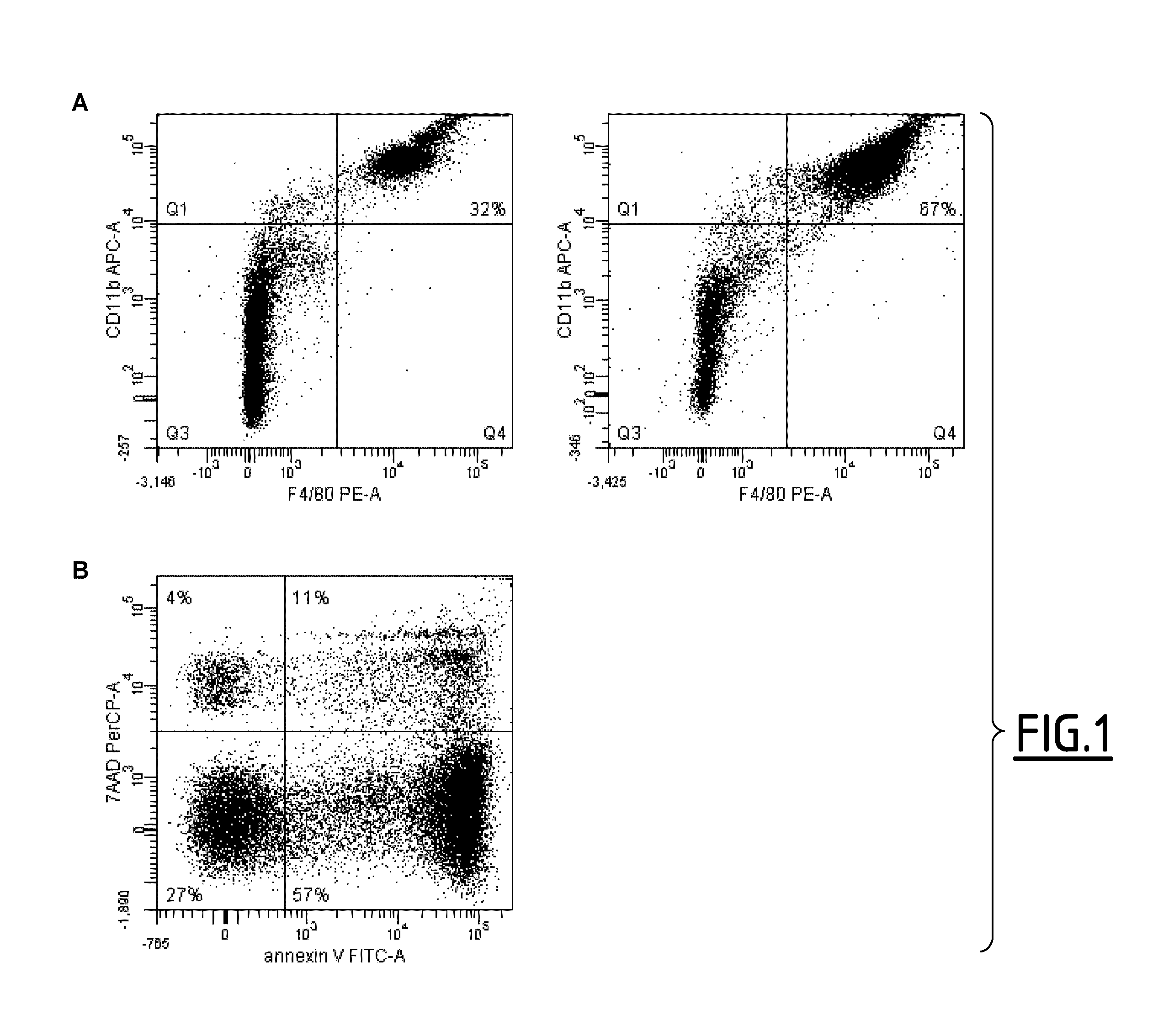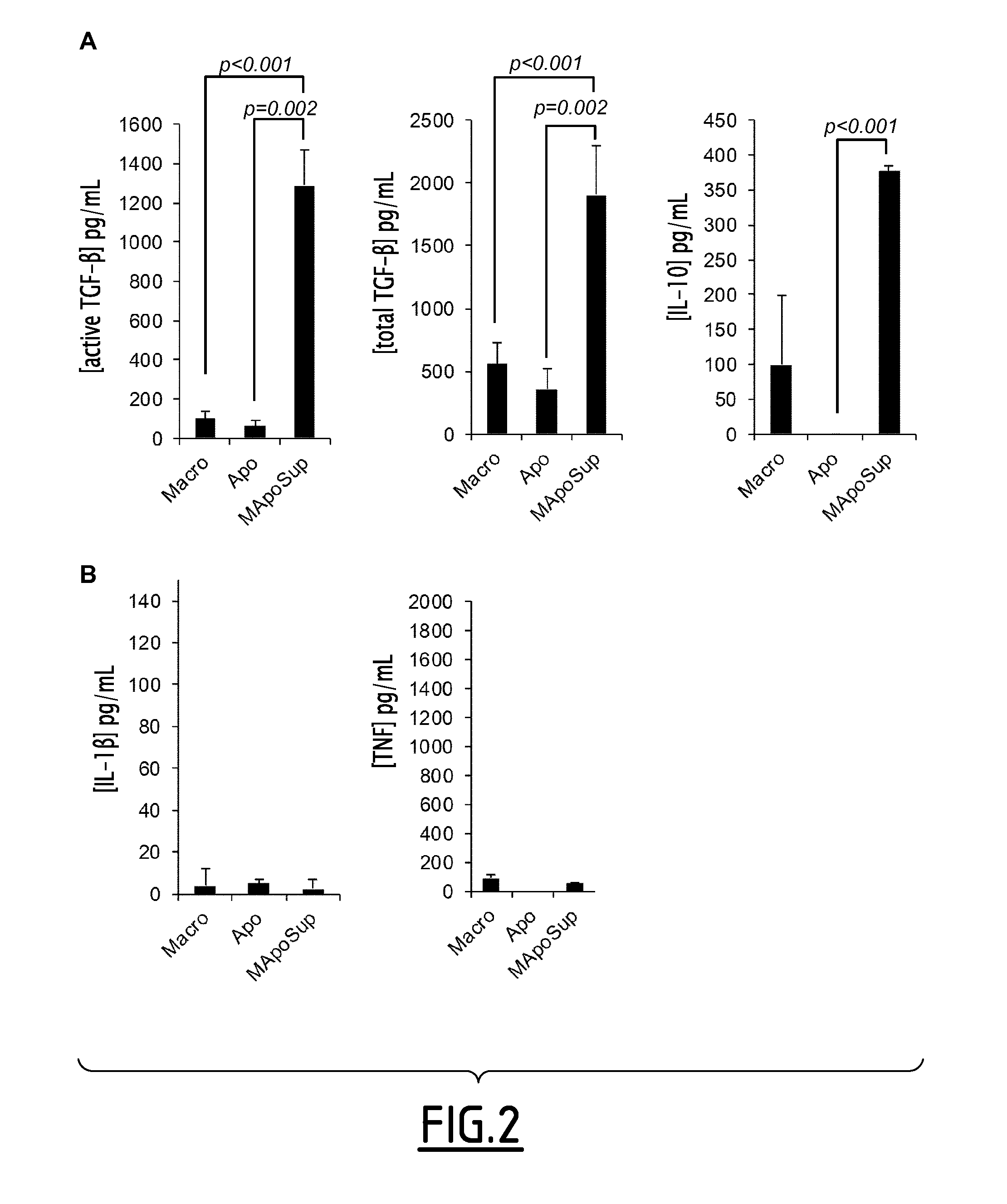Disease therapy using a tolerogenic pharmaceutical preparation
a tolerogenic and drug technology, applied in the field of drugs, can solve the problems of inability to meet the needs of patients, inability to achieve satisfactory treatment, and the traditional method of treating diseases characterized by pathological immune responses with immunosuppressive drugs such as corticosteroid, azathiopine, methotrexate and cyclosporine is far from ideal treatmen
- Summary
- Abstract
- Description
- Claims
- Application Information
AI Technical Summary
Benefits of technology
Problems solved by technology
Method used
Image
Examples
example 1
Treatment of Arthritis Using SuperMApo Treatment
Materials and Methods
Induction and Scoring of Arthritis
[0155]DBA / 1 susceptible mice were immunized by subcutaneous injection at the tail base with 100 μL of bovine type II collagen (200 μg / mL; MD Bioproducts, Zurich, Switzerland) emulsified in CFA (4 mg of Mycobacterium toxin resuspended in 1 mL of IFA, Sigma-Aldrich). Arthritis developed at day 25-28 after collagen immunization in all mice.
[0156]Arthritis severity was determined by daily visual examination of the paws as follows: each limb was scored on a scale of 0-4, where 0=normal paw, 1=swelling of one digit, 2=swelling of one or more digits erythema and severe swelling involving the entire paw. The clinical score for each mouse was the result of the sum of the 4 limbs (maximum score 16).
[0157]Four to five days after the appearance of the first symptoms, mice received a daily dose ip of 200 μL of SuperMApo (supernatant from macrophage-apoptotic cell co-culture) for 6 consecutive d...
example 2
SuperMApo Treatment the Day of Transplantation Delayed GvHD Occurrence and Reduced GvHD Severity
[0169]Graft versus Host disease (GvHD) is a toxic and mostly dead-end adverse of hematopoietic stem cell transplantation (HSCT) in the treatment of hematological malignancies. Such event arises when donor T cells, help by recipient antigen presenting cells, recognize and destruct recipient tissues. Acute GvHD is considered as an inflammatory process that can lead to a chronic form of GvHD more associated with auto-immune features. In this context, it was tested whether SuperMApo treatment would be able to counteract inflammation and prevent or delay GvHD.
Material and Methods
Mice and GvHD Experimental Model
[0170]After a myeloablative conditioning regimen (7 Gy, X-ray irradiation) at day −1, Balb / c mice received C57Bl / 6 bone marrow cells (10.10e6 cells / mouse) depleted with T cells using MACS technology. Six days later, recipient mice were injected with C57Bl / 6 T cells (1.10e6 cells / mouse) t...
example 3
Human SuperMApo Treatment Delays Xenogeneic GvHD
[0172]In order to demonstrate that SuperMApo produced from human cells (hSuperMApo) exhibits the same efficacy to treat inflammation than mouse SuperMApo, it was evaluated whether hSuperMApo treatment is effective to counteract Graft versus Host disease (GvHD) occurrence in a xenogeneic experimental model of GvHD. First, hSuperMApo was qualified in terms of cytokine content and then tested for its efficacy in vivo. Then, it was evaluated whether hSuperMApo treatment was able to inhibit human leukocyte induced GvHD in immunodeficient mice.
Materials and Methods
[0173]Production of hSuperMApo
[0174]Human SuperMApo was issued from the co-culture of macrophages derived from peripheral blood mononuclear cells (PBMC) cultured with apoptotic PBMC. Thus, PBMC were isolated from cytapheresis bag from healthy volunteer through Ficoll gradient centrifugation. Then PBMC were plated for 90 min in complete RPMI culture medium (10% FBS, 1% Penicillin / St...
PUM
| Property | Measurement | Unit |
|---|---|---|
| time | aaaaa | aaaaa |
| weight | aaaaa | aaaaa |
| total volume | aaaaa | aaaaa |
Abstract
Description
Claims
Application Information
 Login to View More
Login to View More - R&D
- Intellectual Property
- Life Sciences
- Materials
- Tech Scout
- Unparalleled Data Quality
- Higher Quality Content
- 60% Fewer Hallucinations
Browse by: Latest US Patents, China's latest patents, Technical Efficacy Thesaurus, Application Domain, Technology Topic, Popular Technical Reports.
© 2025 PatSnap. All rights reserved.Legal|Privacy policy|Modern Slavery Act Transparency Statement|Sitemap|About US| Contact US: help@patsnap.com



